The Best Tomato Varieties to Grow in Your Garden
Published: August 22, 2025 at 9:10:23 AM UTC
Choosing the right tomato varieties for your garden can feel overwhelming with thousands of options available. Whether you're looking for juicy slicers for sandwiches, paste tomatoes for homemade sauce, or sweet cherry types for snacking, this guide will help you select the best tomato varieties to grow in your garden. We've carefully curated this list based on flavor, disease resistance, growing conditions, and purpose to help gardeners of all experience levels enjoy a successful harvest.
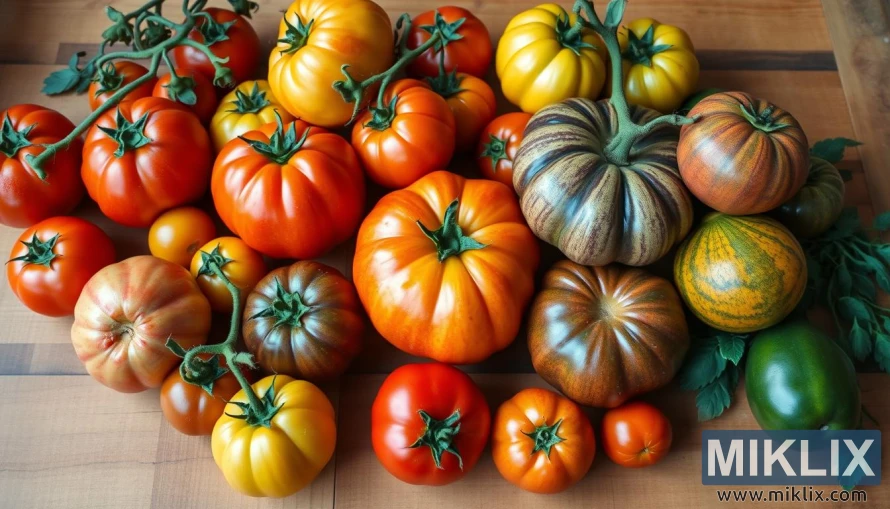
Key Factors to Consider When Choosing Tomato Varieties
Different tomato varieties offer unique flavors, colors, and growing characteristics
Before diving into specific varieties, it's important to understand the key factors that should guide your selection process:
Growth Habit
Determinate varieties grow to a predetermined height (usually 3-4 feet), produce all their fruit within a short period, and then decline. These compact plants are ideal for containers, small spaces, and gardeners who want to harvest all at once for canning.
Indeterminate varieties continue growing and producing fruit throughout the season until killed by frost. These can reach heights of 6+ feet and require sturdy staking or caging. They're perfect for gardeners who want a continuous harvest.
Climate Considerations
Days to maturity is crucial for short-season gardeners. In cooler regions, choose varieties that mature in 60-75 days.
Heat tolerance matters in southern regions where temperatures regularly exceed 90°F.
Disease resistance is especially important in humid areas where fungal issues are common.
Purpose
Slicing tomatoes are juicy with thin skins, perfect for fresh eating.
Paste tomatoes have thicker walls, fewer seeds, and less water content, making them ideal for sauces and canning.
Cherry tomatoes produce small, sweet fruits perfect for snacking and salads.
Seed Type
Heirloom varieties have been passed down for generations, offering unique flavors and characteristics. Seeds can be saved for future planting.
Hybrid varieties are crosses between two parent plants, often offering improved disease resistance and yield. Seeds won't produce the same plant if saved.
Most Flavorful Heirloom Varieties
Cherokee Purple
This beloved heirloom produces medium to large fruits with a distinctive dusky purple-red color and green shoulders. The flavor is rich, sweet, and often described as having a smoky depth unlike any other tomato.
- Growth Type: Indeterminate
- Days to Maturity: 80-85 days
- Flavor Profile: Rich, sweet with smoky undertones
- Best Uses: Fresh eating, sandwiches
- Growing Tips: Provide sturdy support and consistent watering. Tolerates some heat but benefits from afternoon shade in very hot climates.
Brandywine
Often considered the gold standard for tomato flavor, Brandywine produces large, pinkish-red fruits weighing up to 1.5 pounds. The potato-leaf foliage is distinctive, and the flavor is perfectly balanced between sweetness and acidity.
- Growth Type: Indeterminate
- Days to Maturity: 90-100 days
- Flavor Profile: Sweet, rich, with perfect acid balance
- Best Uses: Fresh eating, sandwiches, salads
- Growing Tips: Needs strong support and benefits from pruning to improve air circulation. Slow to set fruit in extreme heat.
Black Krim
This Russian heirloom from the Crimean Peninsula produces medium-sized fruits with dark red-purple skin and green shoulders. The flavor is intense, rich, and slightly salty – a true standout in taste tests.
- Growth Type: Indeterminate
- Days to Maturity: 75-80 days
- Flavor Profile: Complex, rich, slightly salty
- Best Uses: Fresh eating, salads
- Growing Tips: Tolerates heat well but needs consistent moisture. Can crack if watering is irregular.

Best Disease-Resistant Hybrid Varieties
If disease pressure is high in your area or you want more reliable production, these hybrid varieties offer excellent resistance while maintaining good flavor:
Big Beef
This 1994 All-America Selections winner combines old-fashioned tomato flavor with modern disease resistance. Produces large, 12-16 oz beefsteak tomatoes with excellent flavor and texture.
- Growth Type: Indeterminate
- Days to Maturity: 73 days
- Disease Resistance: V, F, N, TMV, ASC, St
- Flavor Profile: Rich, classic tomato flavor
- Growing Tips: Provide strong support for heavy fruit load. Responds well to regular feeding.
Damsel
A newer hybrid that combines heirloom flavor with excellent disease resistance. Produces pink, 8-12 oz fruits with a perfect balance of sweetness and acidity.
- Growth Type: Indeterminate
- Days to Maturity: 73 days
- Disease Resistance: Late blight, nematodes, verticillium wilt
- Flavor Profile: Sweet, rich, balanced
- Growing Tips: Works well in containers with support. Prune for better air circulation.
Chef's Choice Green
This 2016 AAS Winner produces beautiful green fruits with yellow stripes that stay green when ripe. Offers excellent disease resistance and productivity with a delicious, sweet flavor.
- Growth Type: Indeterminate
- Days to Maturity: 85 days
- Disease Resistance: TMV, A, St
- Flavor Profile: Sweet, tangy, complex
- Growing Tips: Fruits may sunburn in extreme heat; provide some afternoon shade if needed.
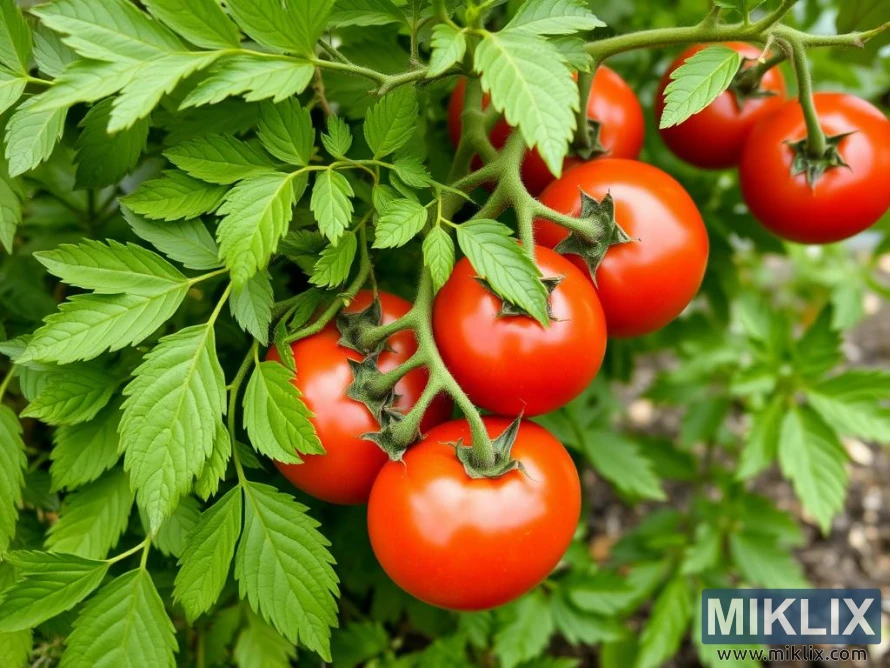
Best Tomatoes for Small Spaces and Containers
Limited garden space doesn't mean you can't enjoy homegrown tomatoes. These compact varieties thrive in containers or small garden plots:
Bushsteak
A compact determinate variety that produces full-sized beefsteak tomatoes on a plant that grows just 20-24 inches tall. Perfect for patio containers or small garden spaces.
- Growth Type: Determinate
- Days to Maturity: 65 days
- Fruit Size: 8-12 oz
- Container Size: Minimum 5-gallon container
- Growing Tips: No pruning needed. Use a cage for support as fruits can be heavy.
Patio Choice Yellow
This AAS Winner produces abundant sweet yellow cherry tomatoes on compact plants perfect for hanging baskets or containers. The cascading habit makes it decorative as well as productive.
- Growth Type: Determinate
- Days to Maturity: 45-55 days
- Fruit Size: 1-inch cherries
- Container Size: Works in containers as small as 12 inches
- Growing Tips: Water consistently to prevent splitting. Feed regularly as container soil depletes nutrients quickly.
Tumbling Tom
Available in both red and yellow varieties, this cascading cherry tomato is perfect for hanging baskets and window boxes. The compact plants produce sweet, 1-2 inch fruits throughout the season.
- Growth Type: Determinate
- Days to Maturity: 70 days
- Fruit Size: 1-2 inch cherries
- Container Size: Hanging baskets, window boxes
- Growing Tips: Allow branches to cascade over container edges. Harvest frequently to encourage production.
Container Growing Tip: All container-grown tomatoes need more frequent watering and feeding than garden-grown plants. Use a high-quality potting mix with slow-release fertilizer, and supplement with liquid tomato fertilizer every 2-3 weeks.

Best Paste Tomatoes for Sauce and Canning
If you're planning to make sauce, salsa, or can your harvest, these paste varieties offer meaty texture, low moisture content, and excellent flavor when cooked:
Roma
The classic paste tomato, Roma produces abundant plum-shaped fruits with thick walls, few seeds, and minimal juice. Its reliability and productivity make it a staple for sauce makers.
- Growth Type: Determinate
- Days to Maturity: 75-80 days
- Flavor Profile: Intensifies when cooked
- Best Uses: Sauce, paste, canning, drying
- Growing Tips: Plant closely (18-24 inches) for maximum yield. Harvest entire crop within a short window.
San Marzano
Considered the premium sauce tomato in Italy, San Marzano produces elongated fruits with thick flesh, few seeds, and a rich, sweet flavor that intensifies when cooked.
- Growth Type: Indeterminate
- Days to Maturity: 80 days
- Flavor Profile: Sweet, low acid, complex
- Best Uses: Premium sauces, canning whole
- Growing Tips: Requires staking and benefits from pruning to improve air circulation. Harvest when fully red for best flavor.
Amish Paste
This heirloom paste variety produces large, oxheart-shaped fruits that offer more juice than Roma but excellent flavor for sauce. The size makes them versatile for both fresh eating and processing.
- Growth Type: Indeterminate
- Days to Maturity: 85 days
- Flavor Profile: Rich, sweet, complex
- Best Uses: Sauce, canning, fresh eating
- Growing Tips: Provide strong support for heavy fruits. Prune to 2-3 main stems for larger fruits.

Best Cherry Tomatoes for Snacking
Cherry tomatoes are often the most productive and easiest to grow. These varieties offer exceptional flavor and abundant harvests:
Sungold
Often considered the sweetest tomato available, Sungold produces abundant clusters of golden-orange cherry tomatoes with a tropical, fruity sweetness that converts even tomato skeptics.
- Growth Type: Indeterminate
- Days to Maturity: 57-65 days
- Flavor Profile: Intensely sweet, fruity
- Best Uses: Fresh eating, salads
- Growing Tips: Can grow 8+ feet tall with proper support. Prone to splitting after rain; harvest promptly when ripe.
Black Cherry
This unique cherry variety produces dark purple-brown fruits with the complex, rich flavor characteristic of black tomatoes but in a convenient snacking size.
- Growth Type: Indeterminate
- Days to Maturity: 65 days
- Flavor Profile: Rich, complex, sweet-tart balance
- Best Uses: Fresh eating, salads, roasting
- Growing Tips: Very vigorous; benefits from pruning to control growth. Resists cracking better than many cherry varieties.
Sunrise Bumblebee
Part of the artisan Bumblebee series, this variety produces beautiful yellow cherry tomatoes with red stripes. The flavor is sweet and mild, perfect for those who prefer less acidity.
- Growth Type: Indeterminate
- Days to Maturity: 70 days
- Flavor Profile: Sweet, mild, low acid
- Best Uses: Fresh eating, colorful salads
- Growing Tips: Provide consistent moisture to prevent cracking. Fruits hold well on the vine when ripe.

Tomato Variety Comparison Chart
Use this quick reference chart to compare key characteristics of our recommended tomato varieties:
| Variety | Type | Growth Habit | Days to Maturity | Disease Resistance | Best Uses |
| Cherokee Purple | Heirloom Slicer | Indeterminate | 80-85 | Moderate | Fresh eating, sandwiches |
| Brandywine | Heirloom Slicer | Indeterminate | 90-100 | Low | Fresh eating, sandwiches |
| Black Krim | Heirloom Slicer | Indeterminate | 75-80 | Moderate | Fresh eating, salads |
| Big Beef | Hybrid Slicer | Indeterminate | 73 | High | All-purpose |
| Damsel | Hybrid Slicer | Indeterminate | 73 | High | Fresh eating |
| Bushsteak | Hybrid Slicer | Determinate | 65 | Moderate | Container growing, fresh eating |
| Roma | Paste | Determinate | 75-80 | Moderate | Sauce, canning, drying |
| San Marzano | Paste | Indeterminate | 80 | Moderate | Premium sauces |
| Sungold | Cherry | Indeterminate | 57-65 | Moderate | Fresh eating, salads |
| Black Cherry | Cherry | Indeterminate | 65 | Moderate | Fresh eating, roasting |
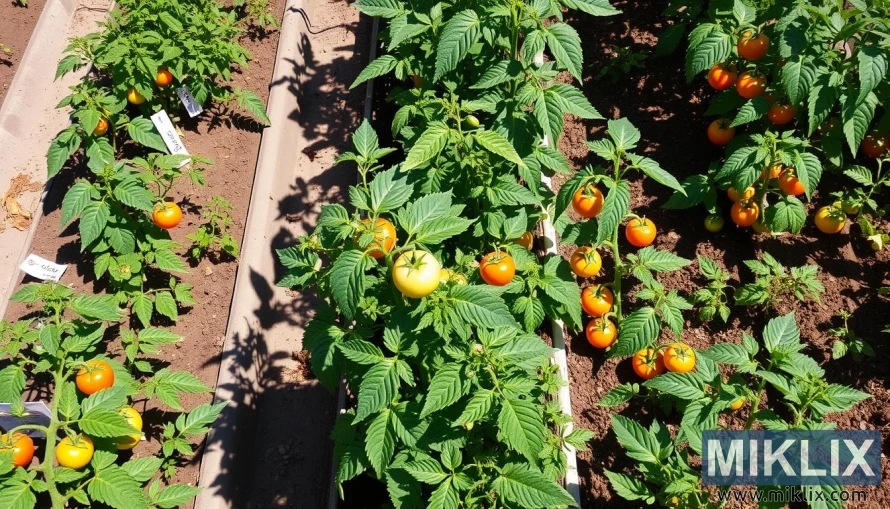
Essential Growing Tips for Success
Starting Seeds
- Start seeds indoors 6-8 weeks before your last frost date.
- Use a seed-starting mix and provide bottom heat for best germination.
- Provide bright light once seedlings emerge to prevent legginess.
- Harden off seedlings by gradually exposing them to outdoor conditions for 7-10 days before planting.
Planting
- Plant in full sun (at least 6-8 hours daily).
- Space indeterminate varieties 24-36 inches apart; determinate varieties 18-24 inches apart.
- Plant deeply, burying 2/3 of the stem to encourage strong root development.
- Add compost and a balanced organic fertilizer to the planting hole.
Support and Pruning
- Install stakes, cages, or trellises at planting time to avoid root damage later.
- For indeterminate varieties, remove suckers (shoots that form in leaf axils) to improve air circulation and direct energy to fruit production.
- Determinate varieties need minimal pruning; focus on removing leaves that touch the soil.
Watering and Feeding
- Water deeply and consistently, aiming for 1-2 inches per week.
- Apply mulch to retain moisture and suppress weeds.
- Feed with a balanced organic fertilizer when planting, then switch to one with less nitrogen once fruits begin to form.
- Avoid overhead watering to reduce disease risk; water at the base of plants.
Tip: Rotate your tomato planting locations each year to reduce disease pressure. Wait 3-4 years before planting tomatoes or related crops (peppers, eggplants, potatoes) in the same spot.
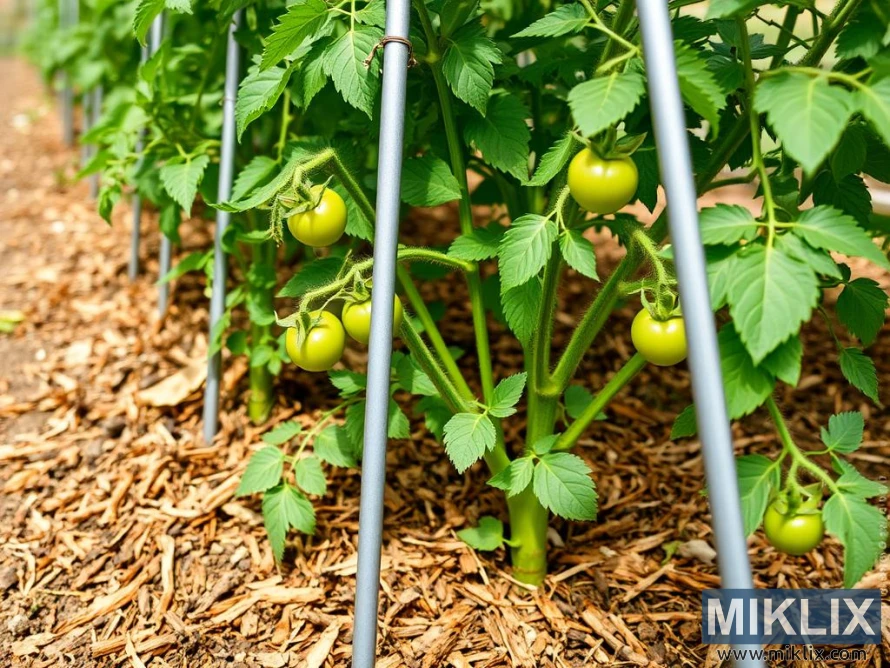
Common Problems and Solutions
Prevention Strategies
- Choose disease-resistant varieties for your climate
- Provide good air circulation between plants
- Water at the base of plants, not on foliage
- Apply mulch to prevent soil splash onto leaves
- Practice crop rotation
- Remove and destroy diseased plant material
Common Issues
- Blossom end rot (calcium deficiency)
- Early blight (fungal disease)
- Late blight (fungal disease)
- Cracking fruits (irregular watering)
- Blossom drop (extreme temperatures)
- Hornworms and aphids (pests)
How do I prevent blossom end rot?
Blossom end rot appears as a dark, sunken area at the bottom of fruits and is caused by calcium deficiency, often due to irregular watering. To prevent it:
- Water consistently and deeply
- Mulch to maintain even soil moisture
- Ensure soil pH is between 6.0-6.8 for optimal calcium uptake
- Add crushed eggshells to planting holes
- Consider a calcium spray if problems persist
What should I do if my tomato leaves are turning yellow or spotted?
Yellowing or spotted leaves often indicate fungal diseases like early blight or septoria leaf spot. Take these steps:
- Remove affected leaves immediately
- Improve air circulation by pruning and proper spacing
- Apply organic fungicides like copper or sulfur as a preventative
- Avoid overhead watering
- Consider replacing severely affected plants

Conclusion
Growing the best tomato varieties in your garden is a rewarding experience that connects you with the joy of producing your own food. Whether you're drawn to the complex flavors of heirlooms, the reliability of hybrids, or the convenience of container varieties, there's a perfect tomato waiting for you to discover.
Start small with 2-3 varieties your first year, then expand your collection as you gain experience. The perfect tomato garden balances tried-and-true favorites with exciting new varieties to discover.
Begin planning now to ensure you have time to start seeds or purchase transplants for the upcoming growing season. Remember that the best tomato varieties to grow in your garden depend on your specific conditions and preferences.
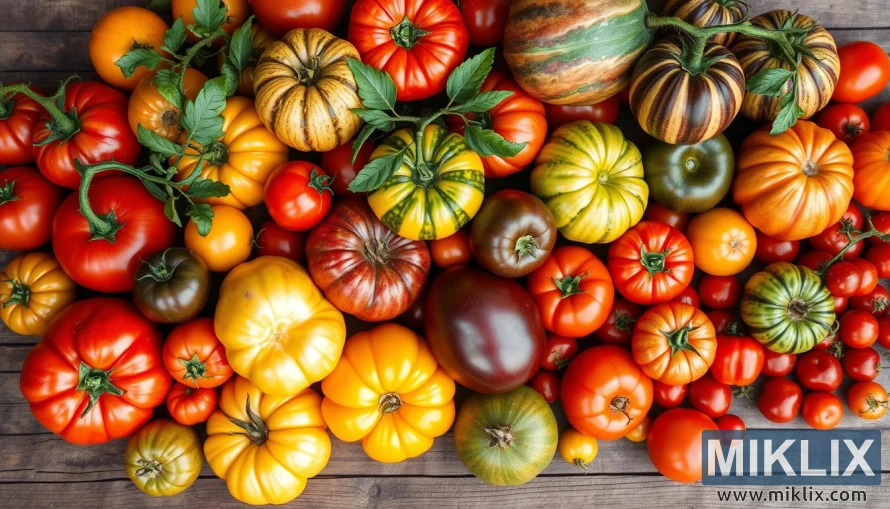
Further Reading
If you enjoyed this post, you may also like these suggestions:
- The Best Strawberry Varieties to Grow in Your Garden
- How to Grow Peaches: A Guide for Home Gardeners
- Guide to Growing Perfect Pears: Top Varieties and Tips
